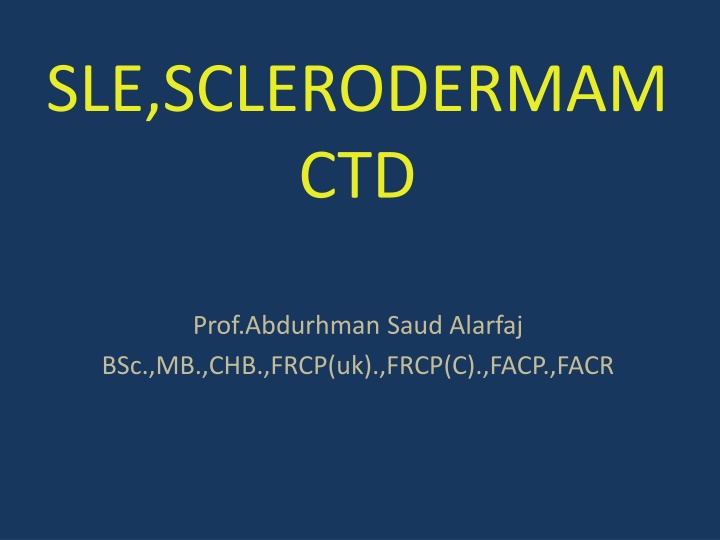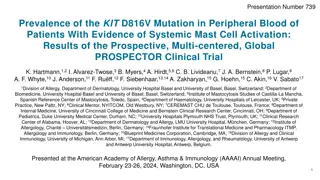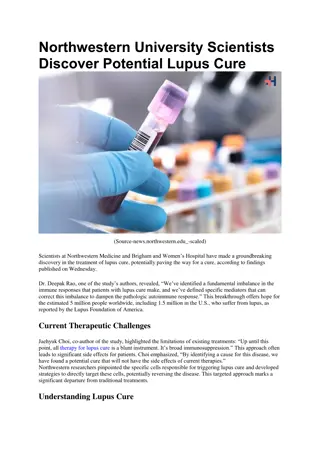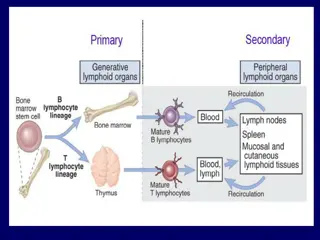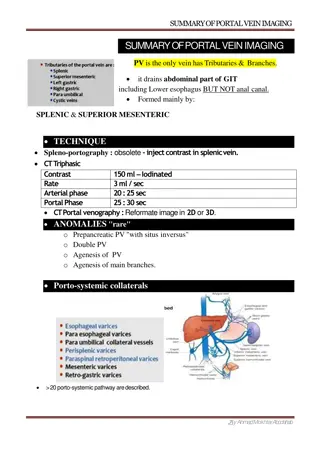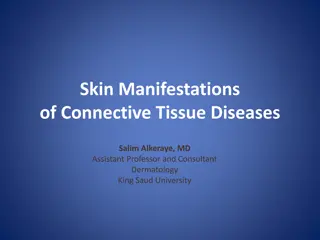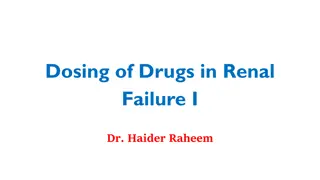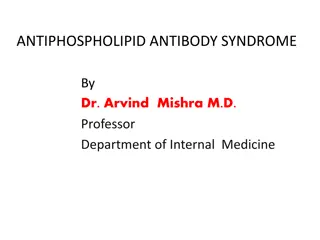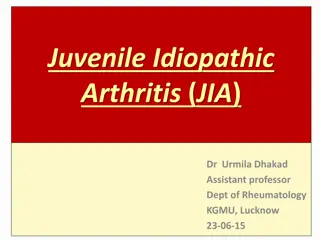Systemic Lupus Erythematosus (SLE) Overview
Systemic lupus erythematosus (SLE) is a chronic, multisystem inflammatory disease characterized by autoantibodies, immune complex formation, and immune dysregulation. It can impact any organ in the body and has specific diagnostic criteria as laid out by the American College of Rheumatology. This condition was first recognized in the 13th century and has evolved in understanding since then. The disease involves various clinical manifestations, such as rashes, arthritis, neurologic disorders, and hematologic abnormalities. Diagnosis involves a combination of clinical findings, laboratory tests, and imaging studies. Treatment typically includes a multidisciplinary approach with medications aimed at controlling inflammation and managing symptoms.
Download Presentation

Please find below an Image/Link to download the presentation.
The content on the website is provided AS IS for your information and personal use only. It may not be sold, licensed, or shared on other websites without obtaining consent from the author.If you encounter any issues during the download, it is possible that the publisher has removed the file from their server.
You are allowed to download the files provided on this website for personal or commercial use, subject to the condition that they are used lawfully. All files are the property of their respective owners.
The content on the website is provided AS IS for your information and personal use only. It may not be sold, licensed, or shared on other websites without obtaining consent from the author.
E N D
Presentation Transcript
SLE,SCLERODERMAM CTD Prof.Abdurhman Saud Alarfaj BSc.,MB.,CHB.,FRCP(uk).,FRCP(C).,FACP.,FACR
Systemic lupus erythematosus (SLE)
Systemic lupus erythematosus (SLE) Definition chronic, multisystem inflammatory disease characterized by autoantibodies directed against self-antigens, immune complex formation, and immune dysregulation resulting in damage to essentially any organ. Background: First written description in13th century( Rogerius) named it lupus( Latin for wolf) as cutaneous similar to a wolf bite. Osler recognized systemic features without skin . Diagnosis with (LE) cells in 1948. In 1959, anti-DNA.
Hochberg MC. Updating the American College of Rheumatology revised criteria for the classification of systemic lupus erythematosus [letter]. Arthritis Rheum 1997;40:1725. Criterion Definition 1. Malar rash Fixed erythema, flat or raised, over the malar eminences, tending to spare the nasolabial folds 2. Discoid rash Erythematous raised patches with adherent keratotic scaling and follicular plugging; atrophic scarring may occur in older lesions 3. Photosensitivity Skin rash as a result of unusual reaction to sunlight, by patient history or physician observation 4. Oral ulcers Oral or nasopharyngeal ulceration, usually painless, observed by physician 5. Arthritis Nonerosive arthritis involving 2 or more peripheral joints, characterized by tenderness, swelling, or effusion 6. Serositis a) Pleuritis--convincing history of pleuritic pain or rubbing heard by a physician or evidence of pleural effusion OR b) Pericarditis--documented by ECG or rub or evidence of pericardial effusion 7. Renal disorder a) Persistent proteinuria greater than 0.5 grams per day or grater than 3+ if quantitation not performed OR b) Cellular casts--may be red cell, hemoglobin, granular, tubular, or mixed
8. Neurologic disorder a) Seizures--in the absence of offending drugs or known metabolic derangements; e.g., uremia, ketoacidosis, or electrolyte imbalance OR b) Psychosis--in the absence of offending drugs or known metabolic derangements, e.g., uremia, ketoacidosis, or electrolyte imbalance 9. Hematologic disorder a) Hemolytic anemia--with reticulocytosis OR b) Leukopenia--less than 4,000/mm<>3<> total on 2 or more occasions OR c) Lyphopenia--less than 1,500/mm<>3<> on 2 or more occasions OR d) Thrombocytopenia--less than 100,000/mm<>3<> in the absence of offending drugs a) "Positive finding of antiphospholipid antibodies based on 1) an abnormal serum level of IgG or IgM anticardiolipin antibodies, 2) a positive test result for lupus anticoagulant using a standard method, or 3) a false-positive serologic test for syphilis known to be positive for at least 6 months and confirmed byTreponema pallidum immobilization or fluorescent treponemal antibody absorption test."Standard methods should be used in testing for the presence of b) Anti-DNA: antibodyto native DNA in abnormal titer OR c) Anti-Sm: presence of antibody to Sm nuclear antigen OR d) False positive serologic testfor syphilis known to be positive for at least 6 months and confirmed by Treponema pallidum immobilization or fluorescent treponemal antibody absorption test 10. Immunologic disorder 11. Antinuclear antibody An abnormal titer of antinuclear antibody by immunofluorescence or an equivalent assay at any point in time and in the absence of drugs known to be associated with "drug-induced lupus" syndrome
EPIDEMIOLOGY: Locally: 2 cases of SLE among 10,372 studied (prevalence of 19.28 per 100,000). Internationally: variable prevalence :. Denmark (21.7/100,000). Britain, 12 cases per 100,000. India prevalence (3.2/100,000) . 39 cases per 100,000 population in Sweden.
AETIOLOGY: Specific cause(s) of SLE is unknown. multiple factors are associated include : Genetic Hormonal Racial Environmental factors
AETIOLOGY(cont.): Genetic predisposition : Multitude of genetic associations suggests a complex genetic predisposition. Concordance rate in monozygotic twins is 25-70%. If a mother has SLE, her daughter's risk of developing the disease is 1:40, and her son's risk is 1:250. Relatives have a high prevalence of other autoimmune diseases. HLA-DR2 and HLA-DR3 and other HLA genes occur more often in SLE than in the general population. null complement alleles and congenital deficiencies of complement ( C4, C2, and other early components) are associated with an increased risk of SLE.
AETIOLOGY(cont.): Hormonal factors: F:M ratio of prevalence in different age groups: In children, f:m ratio is 3:1 . In adults, f:m ratio is 10-15:1 In older, the ratio is approximately 8:1 . Age at onset : 65% have onset between 16 and 55. 20% before age 16 , and 15%t after age 55 . Higher prevalence in men with Klinefelter disease. Exogenous estrogen and exacerbations of SLE. Men at all ages have the same risk of disease as women who are prepubertal or postmenopausal Males do not have an age-related peak in incidence.
Sle in saudi arabia kkuh. asarfaj sex number percent male 58 9.3 female 566 90.7 total 624 100
AETIOLOGY(cont.): Racial andgeography : Higher prevalence (2.5- to 6-fold) in USA African American women than in white women. But,cf occurs infrequently in Blacks in Africa . Higher among Asians, Afro-Americans, Afro-Caribbeans, Hispanic Americans, and Asian Indians. More common in urban than rural areas . Also In New Zealand, 50 per 100,000 Polynesians, but only 14.6 cases per 100,000 in the whites. In France, more common among immigrants from Spain, Portugal, North Africa, and Italy .
AETIOLOGY(cont.): Environmental: worldwide variability of prevalence the disease(black in africa and US) influence of environmental factors on the course of the disease, eg: ultraviolet light viruses drugs.cause or exacerbate silica dust. cigarette smoking. alfa alfa sprouts.
Pathophysiology: Disturbances in the immune system : High ratio of CD4+ to CD8+ T cells. Defects in immune cell tolerance leading to production of autoantibodies targeting antigens located in nuclei, cytoplasm, on cell surfaces, and in plasma proteins. autoantibodies leads to mostly immune complex formation (e.g kidney) and direct antibody-mediated cytotoxicity (hemolytic anemia, thrombocytopenia). Cell-mediated autoimmunity also play part. Tissue damage follows
ORGAN INVOLVEMENT IN SLE Joints Skin -Rashes -Discoid lesions -Alopecia Pleuropericardium Kidney Raynaud s Mucous membranes CNS (psychosis/convulsions) 90% 70% 20% 15% 30% 40% 60% 50% 15%
SLE Presenting and Prevalent Symptoms ARA Criteria [n = 624] SAUDI ARABIA +ve at presentation n(%) +ve on * followup n (%) Total prevalent n (%) ARA Criteria Malar rash 34 299 265 ) 42.5 ( ) 5.4 ( ) 47.9 ( Discoid rash 11 110 99 ) 15.9 ( ) 1.8 ( ) 17.6 ( Photo sensitivity 26 191 165 ) 26.4 ( ) 4.2 ( ) 30.6 ( 223 (35.7) Oral ulcer 21 244 ) 3.4 ( ) 39.1 ( Arthritis 7 461 454 ) 72.8 ( ) 1.1 ( ) 73.9 ( Serositis 82 89 171 ) 13.1 ( ) 14.3 ( ) 27.4 ( Renal disorder 281 18 299 ) 45 ( ) 2.9 ( ) 47.9 ( Neurological disorder 98 20 172 ) 15.8 ( ) 3.2 ( ) 27.6 ( Hematological disorder 505 31 536 ) 80.9 ( ) 4.9 ( ) 85.9 ( Immunological disorder 470 30 500 ) 75.3 ( ) 4.8 ( ) 80.9 ( ANA 622 622 ) 99.7 ( 0 ) 99.7 ( * In addition to those +ve at presentation
Other presenting symptoms (n = 624). Fever (30.6) Weight loss (23.1) Fatigue (42.5) Arthralgia (86.9) Raynaud s phenomenon (8.7) Alopecia (47.6) Lymphadenopathy (20.0) DVT (7.4) Ascites (8.9) Hepatomegaly (3.2) Splenomegaly (2.6) Hepatosplenomegaly (6.1) Genital ulcers (1.4) HTN (28.4) Myalogia (6.6) Pancytopenia (12.2) Pleuritis (15.8) Pericarditis (20.7) Pulmonary symptoms (28.0) Gastrointestinal symptoms (38.6)
Primary Central Nervous System Lupus: Neurologic Signs or Symptoms Meninges Headache Meningismus Cerebrum Dementia Strokes Subarachnoid hemorrhage Migraine Other headaches Myasthenia gravis Seizures Guillain-Barre syndrome Chorea Rigidity, tremor SIADH Cerebellum Ataxia Spine Paraparesis Multiple sclerosis-like disorder Cranial and peripheral nerves Cranial and peripheral sensory,motor neuropathies Mononeuritis multiplex
Special considerations: Drug-induced lupus (consider before diagnosing native lupus) Sex ratios are nearly equal. Nephritis and CNS not common. No anti- native DNA or hypocomplementemia. resolution on discontinuation of drug.
Drugs associated with lupus erythematosus Possible Association Betablockers Methimazole Captopril Nitrofurantoin Carbamazepine Penicillamine Cimetidine Phenytoin Ethosuximide Propylthiouracil Hydrazines Sulfasalazine Levodopa Sulfonamides Lithium Trimethadione Definite association Chlorpromazine Methyldopa Hydralazine Procainamide Isoniazid Quinidine Unlikely Association: Allopurinol, Penicillin, Chlorthalidone, Phenylbutazone, Gold salts, Reserpine,Griseofulvin,Streptomy cin,Methysergide,Tetracyclines,Or al contraceptives
TREATMENT (cont.): GENERAL CONSIDERATIONS : Prevention: Avoid uv light and sun (sunsceening). Antimalarial to prevent relapses. Treat hypertension and dyslipidemias . Treat depending on the organ system(s) involved: Skin, musculoskeletal, and serositis. NSAIDs,HCC,local cs. More serious organ involvement( CNS,renal ) Immunosuppression with high-dose steroids,AZA and/or cyclophosphamide,mycophenolate ,Tacrolimus Targeted therapy(biological) ,rituximab Other treatments plasma exchange for TTP or diffuse alveolar hemorrhage and intravenous immunoglobulin for severe steroid-nonresponsive thrombocytopenia.
PROGNOSIS : Poor prognostic factors for survival in SLE include : Renal disease (especially diffuse proliferative glomerulonephritis). Hypertension renal and central nervous system (CNS) disease less education (?poor compliance) Poor socioeconomic status (?inadequate access to medical care ). Black race (? low socioeconomic status) Presence of antiphospholipid antibodies High overall disease activity Male sex Men similar freq of renal,skin,arthritis,and CNS as women, but less photosensitivity, more serositis, an older age at diagnosis, and a higher one year mortality. Young age SLE in children more severe,higher malar rashes, nephritis, pericarditis, hepatosplenomegaly, and hematologic abnormalities .
Remission After appropriate therapy, many patients go into a clinical remission requiring no treatment. a long-term follow-up of 667 patients noted: 25 % had at least one treatment-free clinical remission lasting for at least one year. The mean duration of remission was 4.6 years ( ?underestimate since one-half of the patients were still in remission at the end of follow-up). A long history of SLE or the presence of renal or neuropsychiatric disease did not preclude remission
Antibodies Associated with Rheumatic Diseases: Percentages of Patients Affected Antibodies to .. Percentages of patients Native DNA SLE: 50% - 60% Sm antigen SLE: 30% Histones Drug-induced SLE: 95% SLE: 60% Rheumatoid arthritis: 20% Sjogren s syndrome: 70% SLE: 30% - 40% Scleroderma and mixed connective tissue disease: frequency and titers low SS-A Sjogren s syndrome: 60% SLE: 15% SS-B
Antibodies Associated with Rheumatic Diseases: (continued) Antibodies to Percentages of patients RNP Mixed connective tissue disease: 95% - 100% SLE: 30% at low titers Scleroderma: 10% - 20% Scl-70 Scleroderma: 10% - 20% Nucleolar antigens Scleroderma: 40% - 50% Centromere antigens CREST: 80% - 90% PM-1 Polymyositis: 50% Dermatomyositis: 10%
